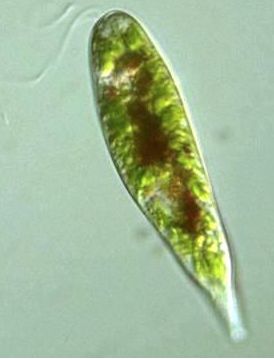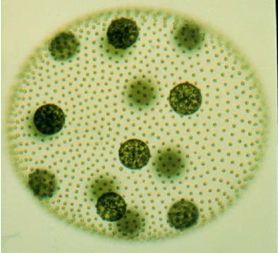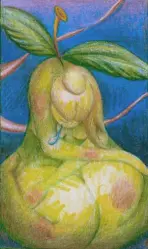Lesson 12: You Seen A Euglena?
This is what they look like:
Alot different from the amoeba, huh? Although they are similar to amoebas in that they are unicellular protists who like to live in quiet ponds and puddles, they have some very important and interesting differences.
First of all euglenas, which are classified into phylum Mastigophora, have a stiff pellicle outside the cell membrane which is far less flexible than the cell membranes of amoebas. So while amoebas can move by randomly changing shape, euglenas keep basically the same oblong shape. They can move in and out a little bit, scrunching long and then round and fat like an earthworm, but most of their motion is through the use of their flagella. The flagella is like a little motorized tail attached in a open reservoir on the front end. The flagella pulls the euglena through the water by spinning around. Print the diagram below so that you can color the pellicle blue, the flagellum black, and the reservoir gray.
Watch this video of a euglena in motion before you continue:

Euglena are both autotrophic and heterotrophic. They have special organelles called chloroplasts which trap sunlight that they use to make their own food just like plants – but they can also absorb food from the water in which they live. In the diagram the chloroplasts look like rods. Color them green. To help them find the sunlight they need, they have special eyespots which are sensitive to bright light. In the diagram the eyespot is near the flagella. Color it red. If not enough light is available, euglenas absorb the remains of other dead organisms through their cell membranes.
The nucleus is near the center with the nucleolus in the center of it. Recall that the nucleus holds the DNA. Color the nucleus purple and the nucleolus pink.
Near the flagella is the sunburst-shaped contractile vacuole – do you remember its function? It controls the amount of water inside the euglena, removing any excess so that the organism will not explode. Color the contractile vacuole orange.
The only thing left to color is the cytoplasm. Let’s color it light yellow.
- To what kingdom and phylum do euglena belong?
- The ability of some organisms to make their own food using sunlight and chlorophyll is called “photosynthesis”. In what organelle does the photosynthesis take place in a euglena?
- Where on a euglena is the flagella?
- Explain two ways in which euglena obtain their nutrition.
- What is the function of the eyespot?
- What is the function of the nucleus?
- What would happen if a euglena did not have a functioning contractile vacuole?
Take a few minutes to check out a prepared slide of a euglena. Draw, on high magnification, a euglena. Try to find the eyespot, the contractile vacuole, the pellicle, a chloroplast, the flagellum, and the nucleus.
Before we move on to paramecium, I want to show you an example of a member of phylum Mastigophora that lives in colonies rather than individually. Here is a picture of a colony of Volvox:
A Volvox is a colony of microscopic individuals, each with two flagella, which join together to create a spherical rolling lattice. Like euglena, volvox are photosynthetic.
If you have a prepared slide of Volvox, check it out now and draw what you see.



